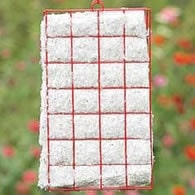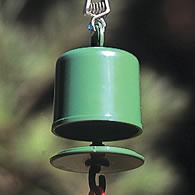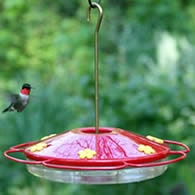Ruby-throated Hummingbird Nesting, Feeding Habits
Ruby-throated Hummingbirds may be small birds, but someone forgot to tell them.
These tiny birds will staunchly defend their territory at the bird feeder during the fall migration.
Males will chase other males away, letting only their females and young feed. (maybe not even them)
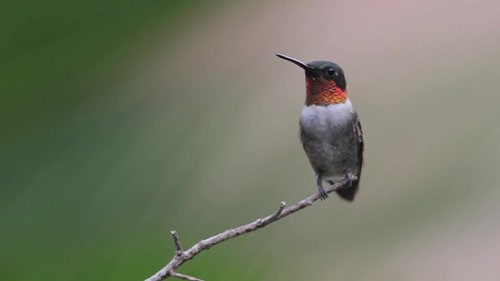
Male Ruby-throated Hummingbird
Ruby-throated Hummingbird Call- Song
The Ruby-throated Hummingbird, like many hummingbirds, is not known for a melodious song like some other bird species.
Instead, it communicates through a variety of chirps, squeaks, and buzzes.
Calls: The most common sound you'll hear from a Ruby-throated Hummingbird is a soft, rapid "chittering" or "chirping" sound.
This is often a series of short, sharp, high-pitched notes, described as "tik-tik-tik" or "tchup-tchup-tchup".
These calls are typically used for communication between individuals, such as during territorial disputes or courtship.
Wing Sounds: The hummingbird's wings also produce a distinctive sound, a rapid humming or buzzing noise that is a result of their incredibly fast wingbeats (up to 53 beats per second for the Ruby-throated Hummingbird).
This is not a vocalization, but it's a key part of the bird's auditory presence.
Aggressive and Alarm Sounds: When a Ruby-throated Hummingbird feels threatened or is defending its territory, it may produce more aggressive sounds.
These can include sharper, louder chirps and buzzes. The sounds can vary between individuals and situations.
The best way to get a sense of these sounds is to listen to recordings or observe the birds in person.
Description
The Ruby-throated Hummingbird only measures 3 3/4 inches long and is the widest-ranging of all North American hummingbirds.
This green and scarlet little hummingbird is the only one likely to be seen east of the Mississippi River, and certainly, the only one to breed in the area.
The male Ruby-throated has green upperparts and an iridescent red throat.
Although depending on light, the throat may appear black. The breast and middle are whitish.
Female Ruby-throats have green upperparts and whitish underparts.
Easy How to Make Hummingbird Nectar Recipe
How to Make Humming Bird Sugar Water Mixture
A feeder filled with sugar-water will attract this relatively tame visitor. Just mix 1 cup of white sugar with 4 cups of water.
Should I Boil the Homemade Hummingbird Food?
You can boil the mixture for 3 or 4 minutes to remove any impurities if you like, but it's no longer mandatory.
The most important chore is to keep your feeders clean. Thoroughly wash them every 3-4 days. And more often during hot temperatures.
I recommend that if you're going to boil the water, boil it without the sugar first.
The amount of water will be reduced during boiling and the nectar will be more concentrated.
The 1 part sugar to 4 parts water is what most closely mimics nectar in the wild.
This ratio can be diluted if bees are on your hummingbird feeders.
Hummingbird Buzzing Around Feeder
What do Ruby-throated Hummingbirds Eat?
Ruby-throated and all other Hummingbirds must eat all day long just to survive.
In addition to nectar from flowers and your sugar-water feeder, these birds eat small insects, beetles, ants, aphids, gnats, mosquitoes, and wasps.
As you can see, it's to your advantage to attract these jewels to your backyard to control insect populations. These wild forms of protein are what they feed their young.
Fruit Flies are a favorite of the hummingbirds diet. Try tucking a ripe banana under a flowering shrub where the flies find it and where you can watch the hummingbirds feed.
Got an interesting story about these birds in your backyard? Please Share it With Our Visitors. Got a picture? - Even Better! To share, start here: Share My Hummingbird Story
Read What Others Have Shared.
When Do I Take My Hummingbird Feeders Down?
Many ask, "When do I need to take my hummingbird feeder down?"
A common myth is that leaving your feeders out too long will cause the hummingbirds to stay longer than they should. This just isn't true.
The recommended best time to stop feeding hummingbirds is two weeks after you no longer see them visiting your yard and feeders. But be aware there can be stragglers.
As long as you still see them visiting, keep providing for them. This will allow them to store fat resources for their long migration.
If a freeze is predicted, bring your feeder indoors for the night and return it as early in the morning as possible. They need to refuel after a cold night.
How Do Hummingbirds Stay Warm On Cold Nights?
We're often asked, "how do hummingbirds stay warm at night?"
Hummingbirds do the normal things birds do, such as puffing out feathers for better insulation and finding sheltered locations to roost.
They also can reduce their temperature and slow their metabolism down. This slowed metabolism is referred to as "Torpor", (see the photo below).

Hummingbird in a State of Topor
Think of it as a mini hibernation just to get through a cold night.
They are not the only birds capable of doing this. Doves, Common Whip-poor-wills, some swifts, and other birds have this ability.
We get emails from visitors who find these birds in a state of torpor and hanging upside down on the feeder.
Other times, early in the morning, some people have picked them off the feeder thinking they were ill.
It is always best to wait and see. Let them come out of this state at their own pace so that no harm is done to the bird.
Hummingbird Breeding Season - When Do They Nest?
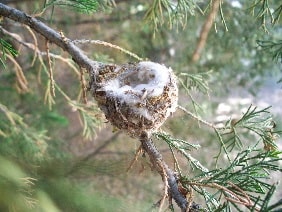
Hummingbird Nest
So when do Ruby-throated Hummingbirds Nest? Depending on whether they breed in the Gulf states or farther North determines when you're most likely to see them.
The Gulf Coast may see males arriving in late February and New Brunswick may have both males and females by late May.
For most of the U.S., anytime between April and late May is when you can expect them.
When females arrive at their territory, they select a nest site and begin building the nest without any help from a male.
An interesting side note is that the females are the only ones that provide care to the young.
When looking for their nest, you'll need a keen eye. Its nest is a cup of plant down and spider web, covered with flakes of lichen, placed 5-20 ft. above the ground.
Look for a horizontal limb with a slight downslope. Often you'll find them in shrubs.
Since they use spider webbing for nest building, they sometimes can get trapped in larger webs.
| Ruby-throated Hummingbird Nesting Stats | |
|---|---|
| Eggs | usually - 2 |
| Incubation | 12 - 14 days |
| Nestling Phase | 18- 20 days |
| Broods | 1 - 2 |
Two white eggs are incubated by the female for 12 to 14 days, sometimes a few days longer.
The young will leave the nest 18 to 20 days after hatching.
The female will continue feeding the young after leaving the nest for about a week
Do Ruby-throated Hummingbirds Reuse Their Nest?
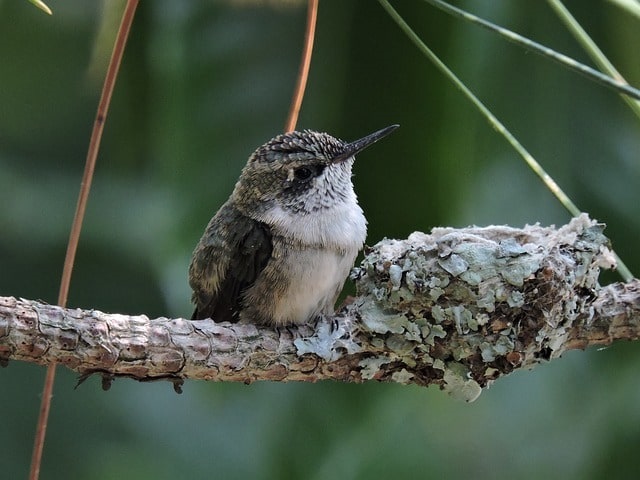
Ruby-throated Hummingbirds don't reuse a nest from season to season but may refurbish and reuse it in the same season for their second brood.
They often return to the same territory from year to year and maybe to the same shrub or tree.
Nests are small and are easily destroyed by winter weather, but it's best to leave them intact when you find one.
May attempt 2 broods each season.
Here are a few interesting facts and behavioral habits:
- In spring, the male defends his territory of about 1/4 acre.
- In dive displays, he flies in a U shape, rising 10-40 ft. on each side.
- After mating, the female builds the nest and raises the young alone.
- The flight speed has been clocked at 25 mph and estimated at up to 50 mph
- Hummingbirds do not ride on the backs of geese during migration. They migrate on their own power.
- Adult Ruby-throated hummingbirds migrate South first. The juveniles will continue to feed and grow stronger before migrating.
As an Amazon Associate, wild-bird-watching may earn commissions on qualifying purchases
Some Ruby-throated Hummingbirds migrate 600 miles across the Gulf of Mexico.
During fall, they will store enough fat to double their weight to make the long trip.
That's quite a feat for a bird that weighs about the same as 2 1/2 paper clips!
What are the Predators of Ruby-throated Hummingbirds?
Predators may include Sharp-shinned Hawk and American Kestrels.
Around feeders, they are often attacked by domestic cats. Bees and wasps around feeders can cause harm by stinging.
More Information:
Attracting Hummingbirds With Flowers And Plants
Migration - When to take Feeders Down
Hummingbird Central is a great resource for following Ruby-throated and Rufous Hummingbirds migration.
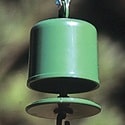 Ant Guard |
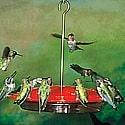 Aspects Bee Resistant |
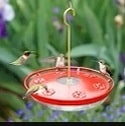 Aspects High View |
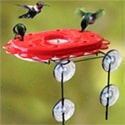 Window Mount |
